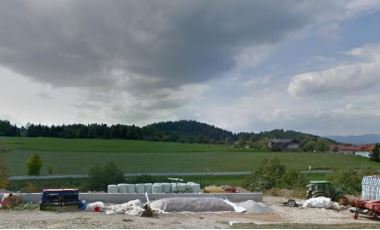Categories
Crop rotation
Mervyn Auchmuty
Success Story
Farming as a Way of Life
Growing up on the family farm, farming for Mervyn Auchmuty has always been his way of life; “I never became a farmer, I was always one”. Now, Mervyn and his father Robert are farming together on their picturesque 400-acre arable (tillage) and mixed livestock farm in County Roscommon.
Minimum Tillage (Min Till)
Mervyn was first introduced to the idea of ‘Regenerative Agriculture’ in 2013, through learning the concept of “minimum tillage” or “min till” (minimum disruption of the soil). The Auchmuty’s land is stoney and therefore difficult to plough, taking many man hours to do so. Removing ploughing from their workload meant less hours ploughing, picking stones, burning diesel, and preparing cropland. The advantages of ‘min till’ were clear for their land. For many, the idea of not ploughing or tilling arable land seems ludicrous, but Mervyn managed to convince his father Robert that it could be a good idea.
Strip-Tilling
And so, the father-and-son duo removed the process of ploughing their soil, and they invested in a “Strip-Till Drill” through the aid of a TAMS (Targeted Agriculture Modernisation Schemes) grant. This Strip-Till allowed the pair to greatly reduce the amount of soil being tilled, only tilling the strips of land where crops were being sown. Mervyn explained the importance of minimum disturbance to the soil for keeping the soil microbes alive, which enhances the nutrient quality of the soil over time. Now the pair also use a “Direct Drill”, which does exactly what it says on the tin; directly drilling the crops into the soil without tilling at all.
Cover Crops
Another benefit to ‘Min Till’ is that most of the soil can remain covered with plants. Mervyn explained how the soil can degrade when there are no plants to cover it; due to factors such as the reduced ability for the soil to absorb carbon and the exposure of the soil to the elements (Sun, Wind, Rain). Therefore, cover crops play a crucial role in the period after crops have been harvested, to cover the bare soil with temporary plants to promote photosynthesis, carbon sequestration and good soil health. The use of cover crops is a practice which many tillage farmers do not observe, yet this changing, increased understanding of the benefits of cover crops through research, and the introduction of government incentives for cover crops are slowly increasing the use of this practice in Ireland.
Improved Root Structure
Mervyn has noticed how the root structure of his crops have improved since he began trialling Regenerative Agriculture practices back in 2013. Plant roots play a vital part in aerating the soil; allowing for better water absorption and providing vital nutrients to the soil.
Natural Fertilisers
The Auchmutys create natural compost with farmyard manure. This process for many farms is now a forgotten practice, as slurry is a more popular modern technique, even though it emits much higher amounts of greenhouse gases (methane, carbon dioxide) and toxic fumes (ammonia and hydrogen sulphide). The creation of natural compost calls for extra time and man hours from the farmers, but the natural benefits are clearly worth it for Mervyn and Robert.
Mervyn has experimented with seaweed and seed washes for naturally fertilising his cropland and seeds. Through his experimentation, he has found that treating seeds before planting leads to longer and stronger root systems and healthier soils.
Part of the Irish Regenerative Agriculture Community
In 2018, Mervyn joined the farmer-run regenerative agriculture group called “BASE Ireland”. Here, farmers share their experiences, ideas, and lessons of advice to other farmers trying out these alternative farming methods. The BASE (Biodiversity Agriculture Soil Environment) group allows farmers to educate each other, chat online, and host knowledge-sharing workshops.
As well as this, Mervyn has engaged in several NOTS (National Organic Training Skillnet) training courses and soil testing initiatives. He has learned a lot from videos on YouTube and through reading internet resources, and he does his part by sharing his knowledge and experience to other farmers through the BASE group.
Engaging in Regenerative Agriculture has kept Mervyn and his father Robert motivated on their farm. Each year, the duo trial new regenerative practices, which helps “keeps it interesting”. Mervyn hopes to continue to learn and trial at least one new regenerative agriculture practice each year.
LABELS: Ireland, Crop Production, Livestock, Green Fertilisation, Biodiversity, Biodynamic Agriculture, Crop Rotation, Min Till
Andrew Bergin, Arable Farmer
Success Story
Andrew Bergin farms a 90-hectare regenerative tillage farm in County Kildare, growing a wide variety of crops from peas, beans, oil seed rape, winter wheat, spring wheat, barley and oats.
Spaces for Nature
Andrew has a variety of hedgerows and natural field margins across his farm to aid biodiversity and pollinator life. Andrew sees pollinators as an indicator of the health of the environment; “if you’ve pollinators, there are a lot of other things going right”.
No Ploughing and Minimum Tillage
In 2013, Andrew saw a demonstration for a new Strip Till machine, and he could immediately see the advantages; “the crops and ground seemed happier”.
Andrew moved away from ploughing that year with the transition phased over 4 years and all arable ground ‘no-till’ by 2017 . In 2022, a 20-year old direct drill was replaced with a new one with the help of a TAMS (Targeted Agriculture Modernisation Schemes) grant . A direct drill machine does exactly what it says on the tin; directly drilling the seeds into the soil, whilst minimally disrupting the soil’s structure.
Protecting the Soil through Cover Crops
Andrew ensures that cover crops, containing a mixture of plant species, are established as quickly as possible after harvest. Maintaining a living root in the soil at all times across the land protects the soil from damage and is a key principle of Regenerative Agriculture.
Cover crops greatly reduce the amount of carbon lost to the atmosphere, as well as making the soil more resilient to extreme weather conditions.
Protecting Ground Nesting Birds
Cover crops come with more benefits than soil health, due to the high rates of nesting birds and other wildlife that are attracted to the diverse landscape. Andrew stated that “the number of ground nesting birds has exploded” since he stopped ploughing, such as Skylarks and Meadow Pippets.
Taking Part in Farmer-Led Regenerative Initiatives
Andrew is part of a project called “Danú Farming Group”, that involves 12 farms who are doing a rigorous study of the process of transitioning from conventional to regenerative farming practices over a 5-year period. Andrew enjoys learning from other farmers and taking pragmatic steps to regenerate his land.
Andrew is also a member of the Irish farmer-run regenerative agriculture group called “BASE Ireland” (Biodiversity, Agriculture, Soil & Environment). Here, farmers share their experience with regenerative agriculture and also share advice to other farmers trying out these alternative farming methods.
Andrew believes that regenerative farming “would be very hard without the BASE community and the internet”. Indeed he doesn’t think he could have ever transitioned to regenerative agriculture without the knowledge on the internet and other farmers.
Andrew’s Advice to Farmers considering Regenerative Agriculture
Andrew encourages farmers who are interested in regenerative agriculture to start slowly, taking one field at a time, for example. For tillage farmers, he suggests hiring a contractor with a no-till drill to trial the minimum till practices on their land. If it works for them, then a gradual conversion to regenerative farming is the way to go.
Regenerative Agriculture: Empowering Farmers
Andrew describes how regenerative farming is “not prescriptive” or conventional in any way. It is about using your own judgement to assess what is happening with the crop, and to apply the practices that make sense to your specific landscape. For Andrew, regenerative agriculture and no-till farming has saved him an “enormous” amount of time and money.
Being Open to New Ways of Working & Different Opinions
Andrew states that engaging in regenerative agriculture involves “keeping a very open mind” and engaging with other people and farmers to discuss new ideas and opinions. Andrew expressed the importance of sharing information “in a non-confrontational way”. He discusses the importance of farm nature walks in allowing farmers to “take the day off to chat” with like-minded farmers who can share stories and ideas with one another.
Challenges to Regenerative Agriculture in Ireland
Andrew discussed how one of the biggest obstacles to regenerative agriculture is first a lack of information, and secondly, having to take the risk of converting to a new way of farming. He hopes that further research in this area will aid in reducing the risks for farmers in their trial-and-error conversion process to regenerative agriculture.
Andrew believes that regenerative techniques can benefit conventional farming in many ways, and he hopes that the Irish advisory bodies begin to recognize this as more research gets published.
Keeping Farming Fresh & Engaging
Since beginning his journey into regenerative agriculture, Andrew states that for him, “farming is a lot more engaging and interesting now”. Andrew has met a wide variety of “interesting people and younger farmers”, expressing how this social element to regenerative agriculture has a huge community and personal development benefit.
He finds it exciting to convince other farmers of the benefits of regenerative agriculture. Andrew recognizes that this less-destructive form of agriculture can look a “bit scruffy looking” at times, but beauty is very much so in the eye of the beholder.
Andrew intends to continue farming regeneratively and is “all the time striving to find better ways” of doing things.
LABELS: Ireland, crop-production, green fertilisation, biodiversity, crop rotation, No-Tillage
Giuntoli’s Farm
Success Story
The Sante Giuntoli’s Farm is located in Troia, a small village in the province of Foggia (Apulia region, Italy). The farm has a surface area of 100 ha with 3 people as permanent staff. They are cultivating the following crops: durum wheat (Triticum durum L.), field bean (Vicia faba subsp. Minor), sunflower (Heliantus annuus L.), and chickpea (Cicer aretinum L.). They have also a small livestock breeding with 20 calves. They apply some of the practices of regenerative agriculture (RA) that are common to soil conservative practices. In particular, they apply a two-year crop rotation, alternating legumes and cereals. They also execute no-tillage soil management and use legumes as cover crops. They apply the abovementioned practices on the overall farm. Specifically, they started to apply previous practices in 2008, and they are still applying them in the present.
The farmer is an agronomist. In 1977, a Professor held a lesson about the benefits of sod seeding, therefore he was very passionate about it. Therefore. he started to apply it very roughly with old machines, but with the new machine for sod seeding ha has entirely converted his farm. He received training from some agricultural associations, but also from the company that sold him the sod seeding machine. However, he received financial support from some regional funds (330 €/ha). After the application of the soil conservative practices, he experienced an increase in gross production, soil organic matter, and soil fertility, but also a reduction of workload. On the other hand, he has had a problem with Lolium and he solved it with the use of a decision-supporting system (DSS). Altogether, the farmer is very happy to apply soil conservative practices.
LABELS: Italy, crop-production, crop-rotation
Bevere’s Farm
Success Story
The Roberto Bevere’s Farm is located in Lesina, a small village in the province of Foggia (Apulia region, Italy). The farm has a surface area of 36 ha with 5 people as permanent staff. They are cultivating the following crops: durum wheat (Triticum durum L.), common wheat (Triticum durum L.), barley (Hordeum vulgare L.), and field bean (Vicia faba subsp. Minor). Nowadays they don’t apply no-tillage management as they have had some problems with the contractor that was carrying out fieldwork. However, they apply a two-year crop rotation, alternating legumes, and cereals. In the past, they carried out no-tillage management in the overall field.
The no-tillage practice has been used from 2014 to 2019. They started to apply no-tillage because they are curious about the innovations. He did not receive training on soil conservative practices, but they have studied in some books. The farmer did not receive any financial support to start soil conservative practices. After the application of the soil conservative practices, he experienced a lower workload and lower costs, especially in terms of fuel, but also an improvement in terms of fertility. On the other hand, he obtained a lower grain yield with respect to previous years, but the lower yield was balanced by the lower costs for cultivation. Altogether, the farmer was very happy to apply soil conservative practices and in the future, he wants to re-apply with no-tillage management because of the high costs of conventional agricultural operations.
LABELS: Italy, crop-production, crop-rotation
Farm Debeljak: Navigating Regenerative Agriculture
Success Story
Farm Debeljak, led by Nastja Debeljak in Slovenia's Osrednjeslovenska region near Velike Lašče, encompasses 61 hectares. Nastja, an agricultural school graduate and current university student, manages breeding, milk processing, and crop production.
The farm is firmly rooted in regenerative agriculture practices, bolstering production optimization. Through minimal cultivation, three-year crop rotations, and a green floor approach, crops like wheat, barley, and alfalfa thrive.
Nastja's inspiration for embracing regenerative methods stems from elevated production costs. Gaining insights from farm visits in Slovenia and abroad and online research, she ardently pursued regenerative insights, despite lacking financial support for her efforts.
The merits of regenerative agriculture, such as humus preservation and enriched soil fertility through green flooring, resonate with Nastja. Yet, challenges surface in the form of crop-threatening wildlife. Fencing solutions emerge but entail expenses.
With satisfaction in their methods, Farm Debeljak pledges commitment to regenerative agriculture. While challenges persist due to uncontrollable factors like wildlife, the farm remains steadfast in its approach, symbolizing resilience in nurturing sustainable practices.
LABELS: Slovenia, dairy, crop-production
